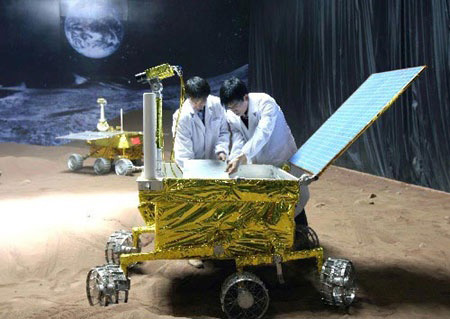China Mulls Plans for New Moon Rock Lab

China is mulling plans for a facility to handle returning moon rock samples as part of a step-by-step plan to explore the lunar surface with robotic probes.
China's multi-step program calls for lunar orbiters to scout the moon, followed by a soft landing on of the surface using an automated lunar rover to reconnoiter the crater-pocked landscape. That rover would then be followed by the touchdown of a lunar lander to collect bits and pieces of the moon and rocket them back to Earth for detailed analysis by Chinese specialists.
A delegation of Chinese space experts touched upon those future moon plans and presented results from the country's Chang'e 1 lunar orbiter earlier this month at the 41st Lunar and Planetary Science Conference (LPSC) in Texas.
China's moon rock plan
China's interest in handling specimens from the moon would seem to mirror in intent NASA's Apollo-era Lunar Receiving Laboratory (LRL) at the space agency's Johnson Space Center in Houston, Texas. Between 1969 and 1972, six Apollo missions brought back 842 pounds (382 kg) of moon rocks, core samples, pebbles, sand and dust.
In 1979, a Lunar Sample Laboratory Facility was built to serve as the chief repository for the returned Apollo samples. It was constructed to provide permanent storage of the lunar sample collection in a physically secure and non-contaminating environment.
As of now, there are few details about what progress is being made in China to set up a laboratory to handle incoming lunar samples, be it by robotic means or perhaps by way of human transport.
"I am aware that there have been inquiries about our curation of lunar samples and I infer that they are interested in our procedures," said Gary Lofgren, a senior planetary scientist and the Lunar Curator at the Johnson Space Center.
Breaking space news, the latest updates on rocket launches, skywatching events and more!
Lofgren said that he was not able to make direct contact with China authorities keen on setting up a lunar receiving lab due to procedures that have to be met for foreign nationals to visit NASA. "I anticipate that we will communicate in the future though there are no specific plans at present," he said.
Microwave moon
China is now preparing a Chang'e-2 lunar orbiter slated for an October of this year sendoff. According to earlier statements by Chinese space officials, the missions in the following two phases will be to conduct a robotic lunar landing via Chang'e-3 in 2013 and an automated sample return in 2017 by Chang'e-4, a spacecraft system capable of hauling back to Earth some 4 pounds (2 kg) of lunar samples.
Jingshan Jiang, deputy principal investigator of Chang'e-1 and the principal investigator of the lunar orbiter's microwave sounder, confirmed China's multi-phased lunar schedule. He is from the Center for Space Science and Applied Research of the Chinese Academy of Sciences.
Jingshan discussed the "microwave moon" as seen by Chang'e-1, an investigation that included a look at helium-3 deposits in the lunar surface as well as probing the presence of water on the moon.
Also presenting at LPSC was Liu Dunyi, apparently the key sparkplug behind efforts to set-up China's lunar sample curatorial facility. Liu is the Chairman of China's national committee of the International Geoscience Program (IGCP) and also holds high positions in China's space exploration program.
Chinese space scientists took part in the pre-LPSC Microsymposium 51, sponsored by Brown University, The Vernadsky Institute of Russia, and the Brown/MIT NASA Lunar Science Institute.
China's long march
"It was fascinating to see scientists from China [at both meetings] enthusiastically outline their plans for rapidly upcoming lunar landers, rovers, and sample return missions, all in preparation for having Chinese taikonauts explore the moon in the near future," said James Head, a leading planetary geologist in the Department of Geological Sciences at Brown University in Providence, Rhode Island.
"I have no doubt," Head told SPACE.com, "that China is on a 'long march' to the Moon and I have little doubt that taikonauts will successfully explore the moon, almost certainly before the United States astronauts return."
Ray Arvidson, the James S. McDonnell Distinguished University Professor at Washington University in Saint Louis, Missouri, also commented on China's lunar exploration ambitions.
"Planning and implementing the lunar sample receiving lab is a logical part of the aggressive Chinese program for lunar exploration," Arvidson said. He told SPACE.com that China's current plans, as he understood them, are to launch another lunar orbiter, then a robotic lunar rover, and then move onto a robotic lunar sample return mission.
"In addition they have started participating in discussions for the International Lunar Network (ILN) mission. And there is discussion of having a launch and deep space transfer capability to Mars for robotic missions by 2013," Arvidson added.
NASA is leading the ILN idea, a concept whereby landed stations on the moon from multiple countries serve as nodes to collectively form a large geophysical network of scientific instruments.
Leonard David has been reporting on the space industry for more than five decades. He is past editor-in-chief of the National Space Society's Ad Astra and Space World magazines and has written for SPACE.com since 1999.

Leonard David is an award-winning space journalist who has been reporting on space activities for more than 50 years. Currently writing as Space.com's Space Insider Columnist among his other projects, Leonard has authored numerous books on space exploration, Mars missions and more, with his latest being "Moon Rush: The New Space Race" published in 2019 by National Geographic. He also wrote "Mars: Our Future on the Red Planet" released in 2016 by National Geographic. Leonard has served as a correspondent for SpaceNews, Scientific American and Aerospace America for the AIAA. He has received many awards, including the first Ordway Award for Sustained Excellence in Spaceflight History in 2015 at the AAS Wernher von Braun Memorial Symposium. You can find out Leonard's latest project at his website and on Twitter.
